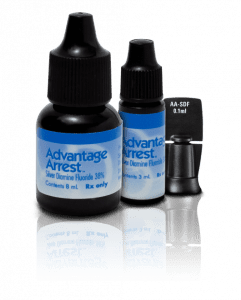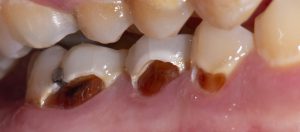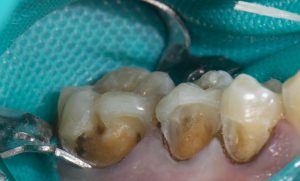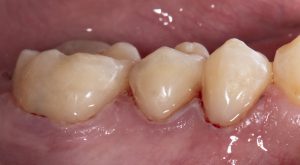OPTIMIZING THE BENEFITS OF SILVER DIAMINE FLUORIDE
Utilized for Adult Caries Management
What is Silver diamine Fluoride (SDF)?
38% SDF is an alkaline, colorless solution with a PH of 10. It contains 24-27% Silver (Ag), 8.5-10% ammonia (NH3) and 5.0-6.0% fluoride.
SDF affects both the tooth structure and the carious lesion:
- Fluoride content promotes remineralization of enamel
- Silver ions inhibit dentin demineralization and prevent subsequent collagen degradation, thereby offering antibacterial protection
- The arrested carious lesion gets covered by a highly remineralized surface zone rich in calcium and phosphate, causing the SDF-treated lesion to turn black
- This blackening of the lesion is due to the formation of silver phosphate
How to use SDF?
- Excavation of soft caries is not required prior to SDF application
- Isolation is accomplished with rubber dam, liquid rubber dam, or cotton rolls
- Prophylaxis of the adherent plaque
- Air-dry the teeth
- SDF is scrubbed onto the carious lesion using a microbrush for one minute
- If using potassium Iodide (KI), a different microbrush is used and rubbed onto the lesion until no further white precipitates are formed
- There is no need to rinse the tooth post application
- If the carious lesion is on a smooth surface, non-esthetic, easily cleansable area; the lesion can be maintained as is with no need to restore (children/ geriatric/ special needs patients).
- If the lesion is to be eventually restored, the SDF treated surface can either be excavated or bonded to.
SDF For Arresting Dental Caries
SDF is the only agent that has been approved by the American Dental Association (ADA) as a “caries arresting medicament” under the CDT code D1354.
- American Dental Association CDT Codes for SDF:
- D1354 – Interim caries arresting medicament application
- D9910 – Application of a desensitizing medicament, per visit
- D1208 -Topical application of fluoride
- Note:
- Reimbursement rates vary from state to state.
- Dental hygienists are well qualified to provide SDF treatment, however, permits vary depending on state level rules.
SDF and Hypersensitivity
Dentin hypersensitivity is known to be caused as a result of hydrodynamic changes in the exposed dentinal tubules which activate intra-dental nerves causing the stimulus of pain, which can be stopped by blocking these exposed dentinal tubules.
SDF was found to be effective in reducing dentinal sensitivity pain in 24 hours to 7 days post treatment.
The Food and Drug Administration (FDA) in 2014 cleared SDF as a class II medical agent to treat/reduce tooth sensitivity.
Advantages of SDF
- Hardens active, soft carious dentin
- Conserves tooth structure
- Cost effective; can help in care system cost reductions
- Effective (heavily supported by research)
Disadvantages of SDF
- Mild, reversible gingival irritations
- Resultant black lesion:
- Recommend getting patient’s written consent prior to use
- Staining of the mucosa, clothes, hands, and counters:
- If staining occurs, reassure them that it will go away in days
- Its high fluoride concentration can potentially contribute to dental fluorosis in young children when used in high doses
Indications of SDF use
- High caries risk adults as an interim step in the caries management and control process
- Patients who have difficulties tolerating conventional dental treatments (Children/ Special needs)
- Root caries
- Patients with severe caries risk due to xerostomia
- Desensitize teeth presenting with hypersensitivity
- Multiple cavitated lesions are too much to finish in one visit, and patient is unavailable for routine appointments
- Limited or no access to a dental clinic (mission trips)
- Non-restorable asymptomatic teeth where extraction is contra-indicated (Head & Neck radiation patients/History of IV Bisphosphonate treatment)
- Geriatric patients and patients confined to nursing homes
Contraindications of SDF use
- Allergy to silver or compounds containing silver
- Patients with ulcerative gingivitis or stomatitis (can be managed with cautious use of a mucosal covering)
- Teeth with irreversible pulpitis or direct pulp exposure
- Potassium iodide (KI)’s use with pregnant or breastfeeding patients due to the risk it may pose to the developing thyroid in a fetus
Companies that sell 38% SDF
-
-
- Advantage Arrest by Elevate Oral Care:
-
-
- Available in: 8ml bottle, 3ml 3-bottle kit and single unit doses
- Formula is tinted blue to aid in visualization
- No accompanied KI bottle
-
- Riva Star by SDI:
-
- Formula is clear
- Available in single dose & 3ml bottles
2 steps: 1st is the application of the SDF, 2nd is the application of the associated KI
Frequently Asked Questions:
What is SDF’s affect on the dental pulp?
SDF induces minimal adverse effects to the pulp. Until further evidence is produced, SDF for direct pulp cap procedures is not recommended.
Does SDF or Potassium Iodide affect bonding or reduce bond strength?
SDF does not affect the microtensile bond strength of composites, whether self-etch or total-etch systems were used. However, it is recommended to excavate the superficial SDF treated layer to avoid grey shadowing under the final restoration and make sure the precipitant is effectively washed away and dried out completely.
What is the frequency of SDF application if the lesions are not restored?
Clinical trials found that by increasing the frequency of application from once to twice per year, the rate of caries arrest increased.
Case Presentation
25 year old male patient presents to clinic with chief complaint of inability to drink and eat comfortably due to generalized teeth sensitivity.
Clinical and radiographic exam revealed generalized rampant caries secondary to poor oral hygiene and overall neglect. After diagnosis and treatment planning discussions, SDF was selected as the initial treatment of choice to help arrest caries and reduce sensitivity to allow for better oral hygiene protocols prior to final restorations being placed.
(1) Active dental carious lesions (Reversible pulpitis)
(2) Arrested carious lesions 7 days post SDF treatment, allowing patient to perform better oral hygiene care before definitive restorations are placed
(3) Cavity preparation (SDF layer removed for better esthetic outcomes)
(4) Immediately post-operative picture. Final composite restorations placed. Notice the dark shadow in the area where SDF treated surface was left (#30)
Conclusion
Although SDF does not restore form and function, its powerful caries-arresting properties allow it to be an important product that can be effectively utilized in multiple clinical situations.
References
- Liu BY, Lo ECM, Li CMT. Effect of silver and fluoride ions on enamel demineralization: a quantitative study using micro-computed tomography. Aust Dent J. 2012;57:65‐70.
- Gao SS, Zhao IS, Hiraishi N, et al: Clinical trials of silver diamine fluoride in arresting caries among children: A systematic review. JDR Clin Translational Res vol 20, issue 10
- Mei ML, Ito L, Cao Y, Li QL, Lo EC, Chu CH. Inhibitory effect of silver diamine fluoride on dentine demineralization and collagen degradation. J Dent. 2013 Sep;41(9):809-17. doi: 10.1016/j.jdent.2013.06.009. Epub 2013 Jun 27.
- Tan HP, Lo ECM, Dyson JE, Luo Y, Corbet EF. A randomized trial on root caries prevention in elders. J Dent Res. 2010;89:1086‐1090.
- Jeremy A Horst, Hellene Ellenikiotis, UCSF Silver Caries Arrest Committee, and Peter M Milgrom. UCSF Protocol for Caries Arrest Using Silver Diamine Fluoride: Rationale, Indications, and Consent.
- Rosenblatt A, Stamford TCM, Niederman R. Silver diamine fluoride: a caries “silver-fluoride bullet”. J Dent Res. 2009;88:116‐125
- Castillo JL, Rivera S, Aparicio T, et al. The short-term effects of diammine silver fluoride on tooth sensitivity: a randomized controlled trial. J Dent Res 2011;90:203–208.
- Quock RL, Barros JA, Yang SW, Patel SA. Effect of Silver Diamine Fluoride on Microtensile Bond Strength to Dentin. Operative Dentistry. 2012; 37(6):610–616.10.2341/11-344-L [PubMed: 22621162]
- Li R, Lo ECM, Liu BY, Wong MCM, Chu CH. Randomized clinical trial on arresting dental root caries through silver diammine fluoride applications in community-dwelling elders. J Dent. 2016;51:15-20. https:// doi.org/10.1016/j.jdent.2016.05.005.
- Slayton RL, Urquhart O.Evidence-based clinical practice guideline on nonrestorative treatments for carious lesions. JADA 2018; 149 (10).
- Zhi QH, Lo ECM, Kwok ACY. An in vitro study of silver and fluoride ions on remineralization of demineralized enamel and dentine. Aust Dent J. 2013;58:50‐56.


 2 steps: 1st is the application of the SDF, 2nd is the application of the associated KI
2 steps: 1st is the application of the SDF, 2nd is the application of the associated KI


